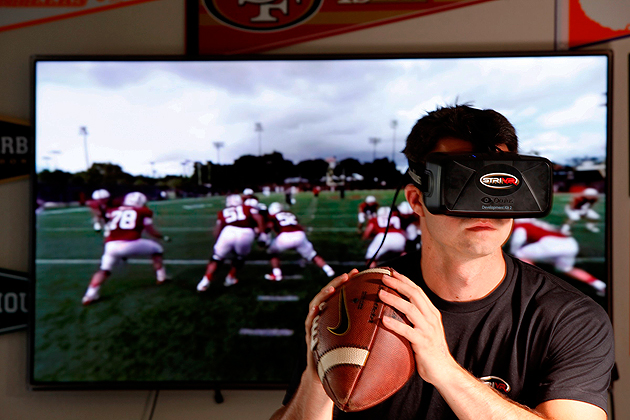The future of sports technology may have made a guest appearance at USC football practice Monday.
According to the Los Angeles Times, representatives from STRIVR, a Palo Alto-based tech company, were in attendance at practice, putting quarterback Cody Kessler and others through a drill while shooting with 3D cameras that enable players to watch themselves later using virtual reality headsets.
STRIVR shoots action in 3D, then allows players to put on headsets and experience virtual reality reps without even being on the field.
The Stanford-developed technology, helped Cardinal quarterback Kevin Hogan during his breakout 2015 season, according to the Times. Hogan’s success reportedly piqued recently hired USC coach Clay Helton’s interest.
Helton, impressed by Hogan’s performance throughout the season, met last month with STRIVR representatives and was intrigued.
“From a quarterback coaches’ view, and how Kevin has progressed up at Stanford with this,” Helton said, “I think it’s invaluable.”
“To be able to put on goggles and get reps without wearing an arm down,” he said, “or being able to play live reps when you’re in an offseason, is invaluable, so we’re looking into it.”
In August, Sports Illustrated profiled the new virtual reality technology in a story titled “Unreal: Virtual reality is changing how college football teams train, recruit.” That piece chronicled how some programs, including Michigan, use the immersive technology to recreate scenes from before or during games, to give recruits an idea of what their program is like. Here’s a fascinating passage:
Kavanaugh puts the headset on Jehu Chesson, a receiver from St. Louis. His response is immediate. And loud.
“Oh, snap!”
“Oh, my God!”
“Pick, baby! Ooooh, go right there!”
When Chesson pulls off the headset he says, “Can I get some water? I’m thirsty.”
“It’s like he played or something,” someone murmurs in the back.
Yes, it is. What Chesson watched was Headcase’s demo reel, a two-minute-and-30-second mash-up of almost three hours of footage filmed on Nov. 16, 2014, the day Oregon State shocked then No. 6 Arizona State 35–27 in Corvallis. Because Kavanaugh is a former OSU walk-on receiver, class of 2009, he had unfettered access to the Beavers’ facilities and sideline that day, and the reel makes the viewer feel like part of the team. Hit play, and suddenly you’re in Oregon State’s locker room for the pregame meeting, compelled to take a knee. Beavers coach Mike Riley (now at Nebraska) looks as if he’s right in front of you; turn around and you see every member of the team. Chesson felt like one. He ran through the tunnel onto the field and sprinted up the sideline during a pick-six. When spectators rushed the field to celebrate, he instinctively recoiled to avoid being knocked over.
Defensive tackle Maurice Hurst Jr. takes his turn, and when he takes off the headset, he seems overwhelmed. “Man,” he says, shaking his head. “And I thought Google Maps was cool.”
“I thought it would be like Viewfinders, like when you were a little kid,” Chesson says. “When you pull down [the lever] and—click!—the picture would change. What I just watched, that’s mind-blowing stuff. You can feel the energy. It’s like you’re right there.”
That sure sounds like something USC, and every other program in America, could use or what every gamer wants to try.








Comments are closed.